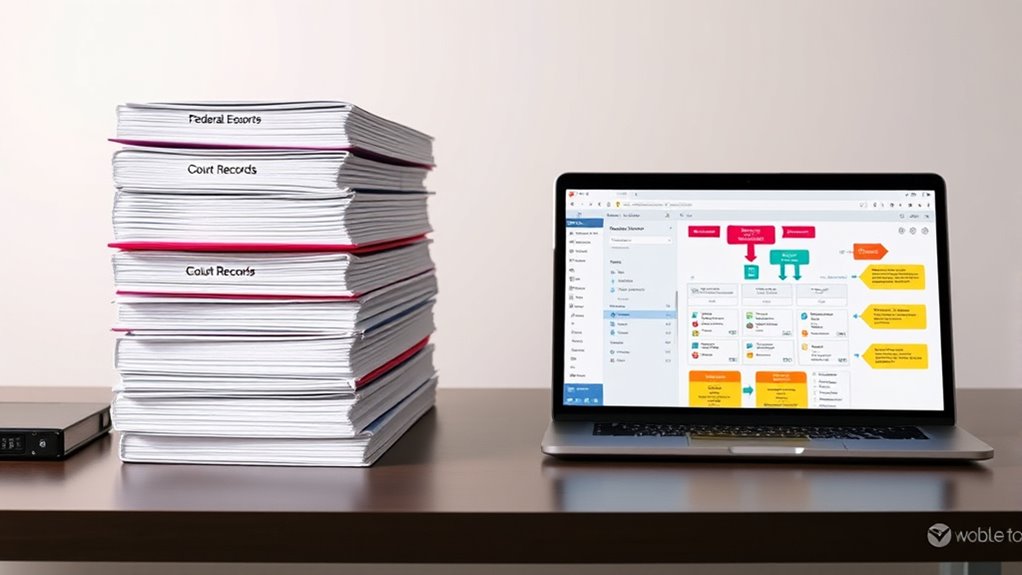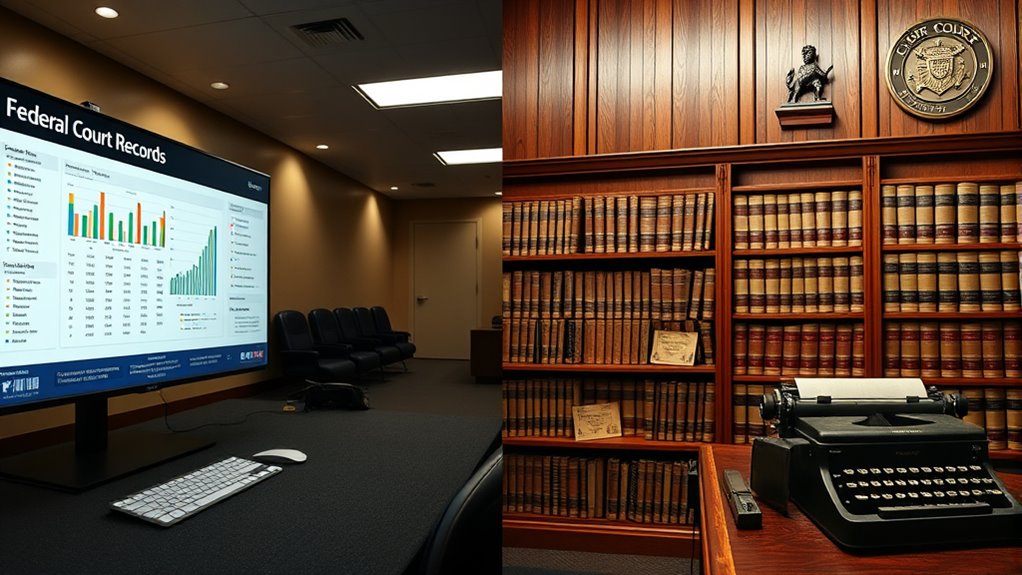Federal court record systems, like PACER, are mostly digital, offering quick online access, search tools, and downloadable data, which makes finding case information easier and more transparent. In contrast, state court systems vary widely; some are fully electronic, while others rely on paper records stored off-site, causing delays and limited access. If you’re curious about how these systems compare in detail, you’ll find insightful information coming up.
Key Takeaways
- Federal court records are primarily accessed via centralized digital platforms like PACER, offering comprehensive online search and download options.
- State court systems vary widely, with some offering full digital access and others relying on paper records and in-person retrieval.
- Federal systems generally provide greater transparency and data accessibility through standardized online portals and bulk download features.
- State court record systems tend to be decentralized, with inconsistent infrastructure, leading to variable accessibility and record management practices.
- Federal courts utilize electronic filing and case management systems, whereas many state courts still depend on manual, paper-based record handling.
Overview of Federal Court Record Access

Federal court record access is primarily facilitated through electronic systems designed to provide timely and efficient retrieval of case documents. The main platform for this is PACER, which allows you to search, view, and download federal court filings and dockets online. PACER’s user-friendly interface lets you access a wide range of case information from district courts, circuit courts, and the Supreme Court. You can register for an account and pay nominal fees per document or docket view. In addition to PACER, RECAP offers free access by collecting federal filings through user contributions. While some courts still manage paper files, most federal courts have shifted to electronic systems, streamlining access and reducing delays in obtaining case records. Eye patches are an example of beneficial skincare products that enhance appearance, similar to how efficient record systems improve accessibility. Many courts also provide public terminals where users can view records without an account, further increasing access options.
State Court Record Systems and Variability

Have you noticed how state court record systems vary widely across different jurisdictions? Some states offer exhaustive online access, allowing you to view case files and dockets easily. Others still rely heavily on paper records or require in-person visits, which can slow down your research. Variability extends to how records are organized and stored, with some states using centralized electronic systems and others maintaining decentralized archives. This inconsistency can make it challenging to navigate or compare records across states. Additionally, access restrictions differ; some jurisdictions limit public viewing of certain case details, while others provide broad access. These differences reflect each state’s resources, technological infrastructure, and policies, creating a patchwork of record-keeping practices that influence how efficiently you can find and use court records. Moreover, record organization strategies directly impact the speed and accuracy of accessing case information. The implementation of digital record systems can further streamline or complicate the retrieval process depending on their sophistication and user-friendliness. As the development of electronic court records progresses, some jurisdictions are seeing significant improvements in record accessibility and searchability, and standardization efforts are being explored to address these disparities.
Digital vs. Paper Filing Methods

While many courts are shifting toward electronic filings, some still rely heavily on paper documents, creating a significant divide in how case information is managed. Federal courts, through systems like PACER, have embraced digital filing, offering quick, remote access to case records. This changeover improves efficiency, reduces physical storage needs, and streamlines case management. In contrast, many state courts still depend on paper filings due to limited technological infrastructure, leading to slower processing and increased risk of lost or damaged documents. Handling paper files requires manual sorting, scanning, and storage, which can delay access and complicate case tracking. As a result, the divide between digital and paper methods impacts not only efficiency but also the reliability and accessibility of court records across jurisdictions. Hydrocolloid technology promotes healing by drawing out impurities, making it a popular choice for effective acne treatment.
Tools for Federal Court Record Retrieval

Accessing federal court records has become more efficient thanks to specialized digital tools designed for streamlined retrieval. The PACER system is your primary resource, offering electronic access to docket sheets, case documents, and filings from federal courts nationwide. It allows you to search by case number, party, or keywords, providing quick access to relevant information. PACER also offers subscription-based services for bulk data downloads and advanced searches. Additionally, the RECAP database, a free extension, enhances PACER by collecting and sharing court filings contributed by users. These tools eliminate the need for in-person visits or paper requests, making it easier to find and review federal court records efficiently. Digital accessibility features further improve user experience by enabling easier navigation and search capabilities. Together, PACER and RECAP optimize your ability to access critical federal legal information swiftly and reliably. Cookies and other digital tools play a role in enhancing the user experience while accessing these systems. Incorporating digital security measures ensures the privacy and integrity of your searches and data, safeguarding sensitive information in accordance with privacy and security standards. Additionally, implementing user authentication protocols helps protect confidential records from unauthorized access.
Methods for Accessing State Court Records

You can access state court records through electronic options or by visiting courts in person. Electronic access varies by state, with some offering online portals and others requiring physical requests. Understanding these methods helps you choose the most efficient way to obtain the records you need. Additionally, knowing about public record systems can sometimes assist in locating certain public records or related information. Being aware of digital record access options can further streamline your search process. Exploring online search tools can also facilitate quicker retrieval of specific case information, especially when combined with secure online platforms that ensure privacy and data integrity.
Electronic Access Options
State courts employ a variety of electronic access options to provide public and legal professionals with court records. Many states offer online portals where you can search for case information, view dockets, and sometimes access documents directly. These platforms often require registration or subscription, but some provide free access to basic case details. Additionally, states might participate in regional or national systems like CourtListener or RECAP, which aggregate federal and state filings. Some courts also provide downloadable datasets or APIs for bulk data retrieval, useful for research or analysis. While electronic access improves convenience and efficiency, availability and features vary widely by jurisdiction. Always check the specific court’s website for instructions, access levels, and any associated fees. Utilizing court record systems can enhance the speed and accuracy of information retrieval for various legal and research purposes, especially considering the ongoing technological advancements in data access. Moreover, many jurisdictions are working towards increasing the availability of digital records, making it easier for users to obtain information without visiting courthouses physically. These digital systems often incorporate secure login protocols to protect sensitive information and ensure user privacy, and some jurisdictions are exploring mobile access options to reach users more effectively.
In-Person Record Requests
To obtain court records in person, you typically visit the courthouse where the case was filed or is being handled. You’ll need to identify the correct court and its hours of operation. Bring valid identification and any specific case details, such as case number, party names, or filing date. Some courts have dedicated clerk’s offices for record requests, and staff can guide you through the process. You may need to fill out a request form and pay a fee for copies. In some cases, records are stored off-site or in a different department, which could require additional time or arrangements. Be prepared for possible waiting periods and ensure you follow the court’s procedures for accessing or requesting copies of the documents.
Data Management and Governance Practices

Effective data management and governance practices are essential for guaranteeing the integrity, security, and accessibility of court records across jurisdictions. You need to understand how courts organize, protect, and share data to maintain trust and efficiency. Key practices include:
- Establishing clear policies for data quality, privacy, and security to prevent breaches and inaccuracies.
- Implementing standardized procedures for electronic and paper records to ensure consistency and reliability.
- Utilizing technological tools like case management systems and data audits to monitor data integrity and compliance.
Case Tracking and Recordkeeping Technologies

You rely on case tracking and recordkeeping technologies to manage court documents efficiently. Digital docket management and electronic filing systems streamline access and updates, improving transparency and speed. Understanding how data governance practices support these tools can help you evaluate their effectiveness across federal and state courts.
Digital Docket Management
Digital docket management has transformed how courts track cases and maintain records by leveraging advanced technologies. It streamlines case monitoring, improves accuracy, and enables quicker access to information. You can expect these key features:
- Automated updates keep case statuses current, reducing manual effort.
- Centralized systems allow quick retrieval of case details and documents.
- Integration with other legal tools enhances workflow and efficiency.
With digital docket management, courts can efficiently organize case timelines, track filings, and monitor proceedings in real-time. This technology minimizes errors, reduces paper dependence, and accelerates information sharing across jurisdictions. Federal courts use systems like PACER to manage their dockets, while many state courts adopt similar digital platforms. Overall, digital docket management modernizes recordkeeping, making case tracking more transparent, accessible, and reliable for users.
Electronic Filing Systems
Electronic filing systems have revolutionized how courts manage case tracking and recordkeeping by automating document submission and organization. You can file documents digitally, reducing reliance on paper and streamlining workflows. Federal courts primarily use PACER for electronic filings, providing real-time access to case dockets and documents. Many state courts are adopting similar systems, although their capabilities vary. These platforms enable you to track case progress, receive notifications, and access records conveniently from anywhere. Automated document management minimizes errors and guarantees accurate recordkeeping. You also benefit from faster updates and improved transparency. Overall, electronic filing systems enhance efficiency, reduce delays, and make case management more accessible for users navigating federal and state court processes.
Data Governance Practices
Data governance practices in case tracking and recordkeeping technologies are essential for ensuring the accuracy, security, and accessibility of court records. They establish standards and policies that protect sensitive information while enabling efficient case management. Proper governance helps prevent data breaches, reduces errors, and maintains the integrity of records across jurisdictions. You should focus on implementing consistent data entry protocols, regular audits, and secure storage solutions.
Here are three key aspects to contemplate:
- Developing standardized procedures for data entry and updates.
- Ensuring secure access controls and encryption methods.
- Conducting routine audits to verify data accuracy and compliance.
These practices enable courts to manage caseloads effectively, support transparency, and uphold public trust in the justice system.
Comparing Data Availability and Transparency

While federal courts have made significant strides in promoting transparency, access to their records still tends to be more consistent and easier to obtain than in most state courts. The PACER system provides a centralized, digital platform for federal documents, making searches straightforward and efficient. Federal records are generally more accessible through online databases like PACER and RECAP, which aggregate filings and case information. In contrast, state courts vary widely; some offer electronic access, while others require in-person requests or limited online portals. Transparency levels depend on each state’s infrastructure and policies. Federal courts’ streamlined digital systems foster greater openness, whereas state courts often face challenges due to inconsistent technology adoption and resource constraints, affecting overall data availability and transparency.
Frequently Asked Questions
How Do Federal and State Courts Differ in Record Confidentiality?
You’ll find federal and state courts differ markedly in record confidentiality. Federal courts typically follow strict rules, making most records publicly accessible through systems like PACER, though some sensitive cases are sealed. State courts vary widely; some keep records private or restricted, especially for juvenile or family cases, while others provide open access. You should always check specific court policies to understand confidentiality levels for each jurisdiction.
What Are the Costs Associated With Accessing Court Records Federally and Locally?
You’ll find federal court records typically cost money through PACER, charging a small fee per page or document, which can add up if you’re accessing many records. State court costs vary widely—some offer free online access, while others charge for copies or in-person requests. Be prepared for potential charges for printing, copying, or certified copies, and check each court’s policies beforehand to avoid surprises.
Are There Restrictions on Public Access to Sensitive Court Documents?
Did you know federal courts process over 300,000 cases annually? You should know there are restrictions on public access to sensitive court documents. Confidential information like social security numbers, trade secrets, and minors’ details are often sealed or redacted to protect privacy. Access may be limited or require special permissions, especially for juvenile or national security cases. Always check court rules to understand what’s available and what’s restricted.
How Long Does It Typically Take to Obtain Court Records From Each System?
It usually takes a few minutes to a few days to get court records from federal systems like PACER, especially for digital access. For state courts, it varies more—some offer online retrieval, which is quick, while others may require in-person or mail requests, taking days or weeks. Your speed depends on the court’s system, record type, and whether you access records electronically or need to request them manually.
What Are the Security Measures for Protecting Digital Court Records?
You’re responsible for ensuring digital court records stay secure. Courts implement security measures like encryption to protect data during transmission and storage. Access is controlled through secure login credentials and user authentication, limiting data to authorized personnel. Firewalls, intrusion detection systems, and regular security audits help prevent unauthorized access or breaches. Additionally, courts enforce strict data governance policies, ensuring compliance with privacy laws and maintaining the integrity of sensitive case information.
Conclusion
You now see how federal and state court record systems differ in access, technology, and transparency. Did you know that over 90% of federal court records are now digitized, making retrieval faster and more efficient? This shift highlights the growing importance of digital tools in the justice system. As these systems evolve, understanding their strengths and limitations helps you navigate legal records more effectively, ensuring you stay informed and empowered in your research or cases.








